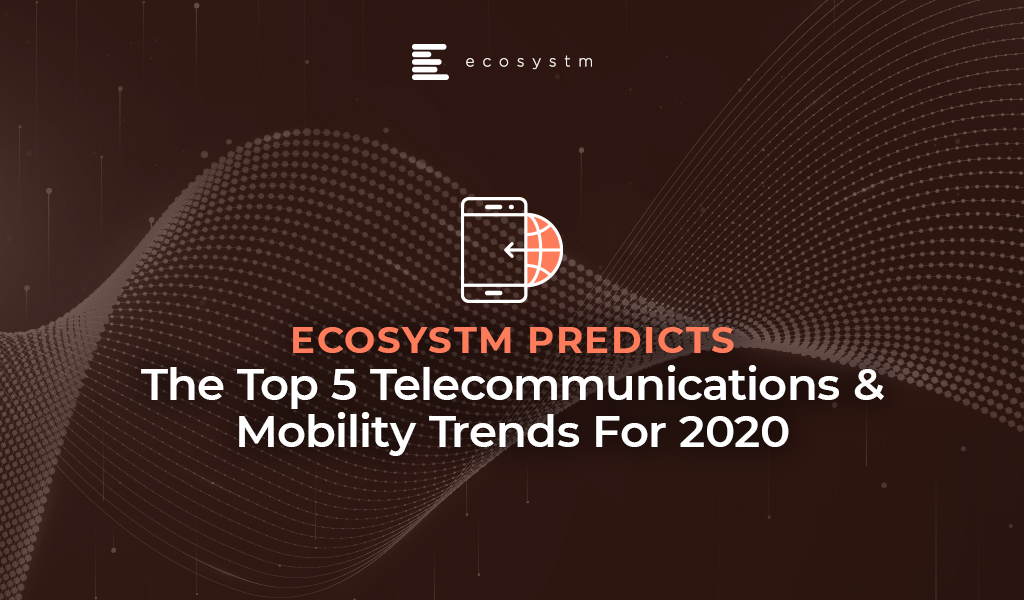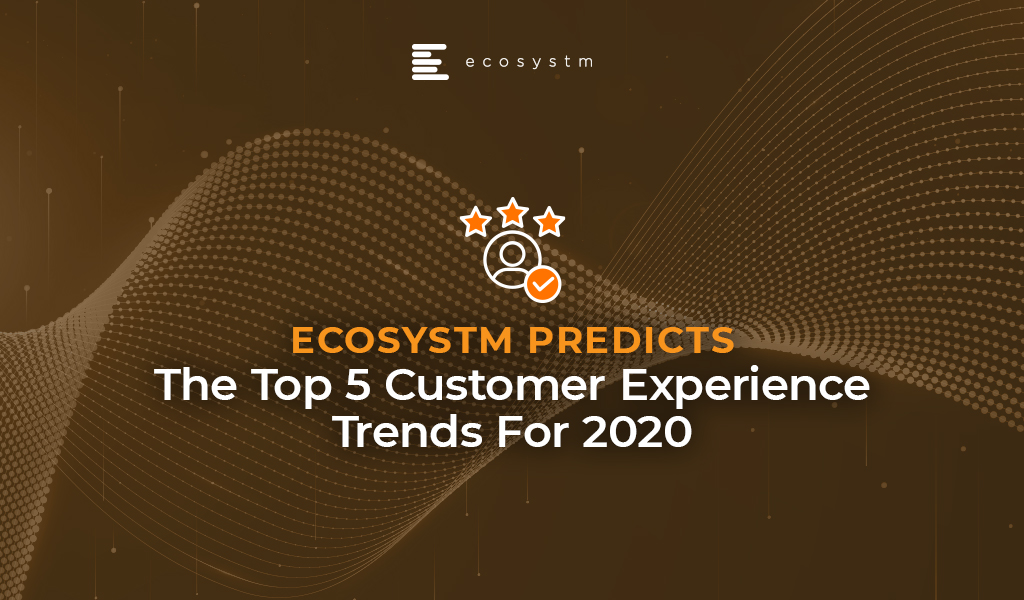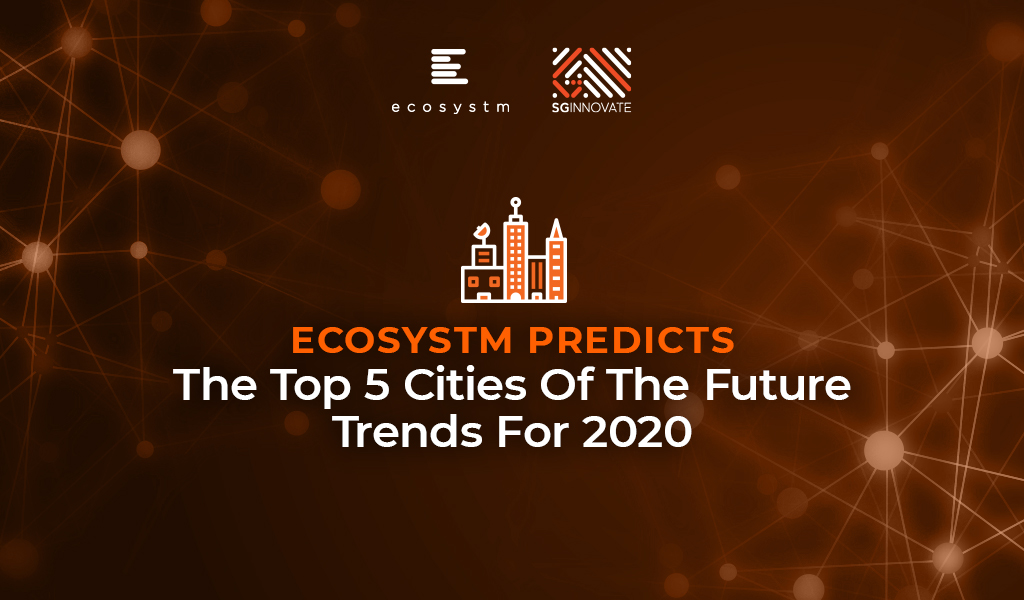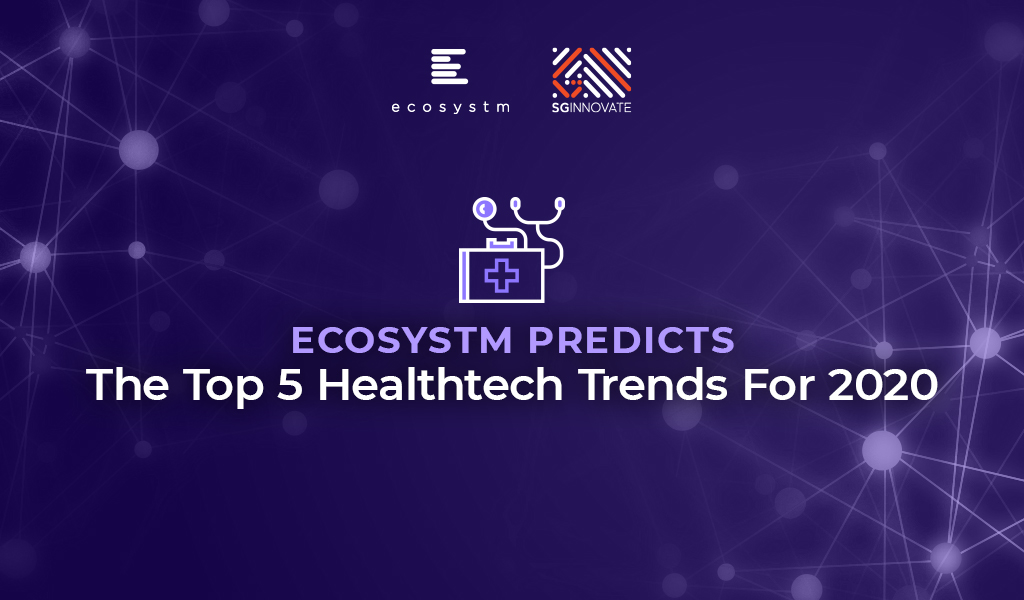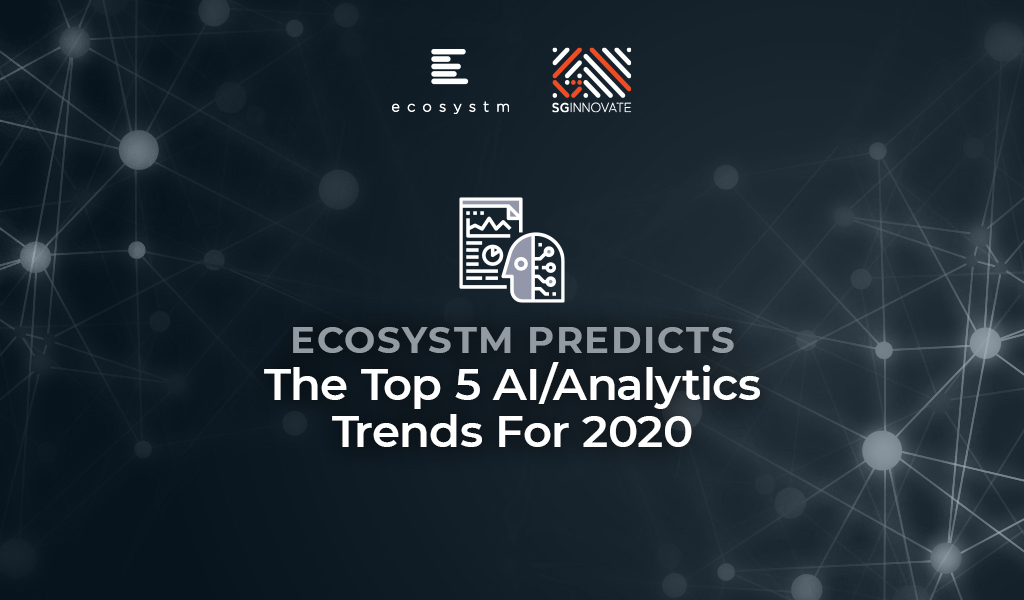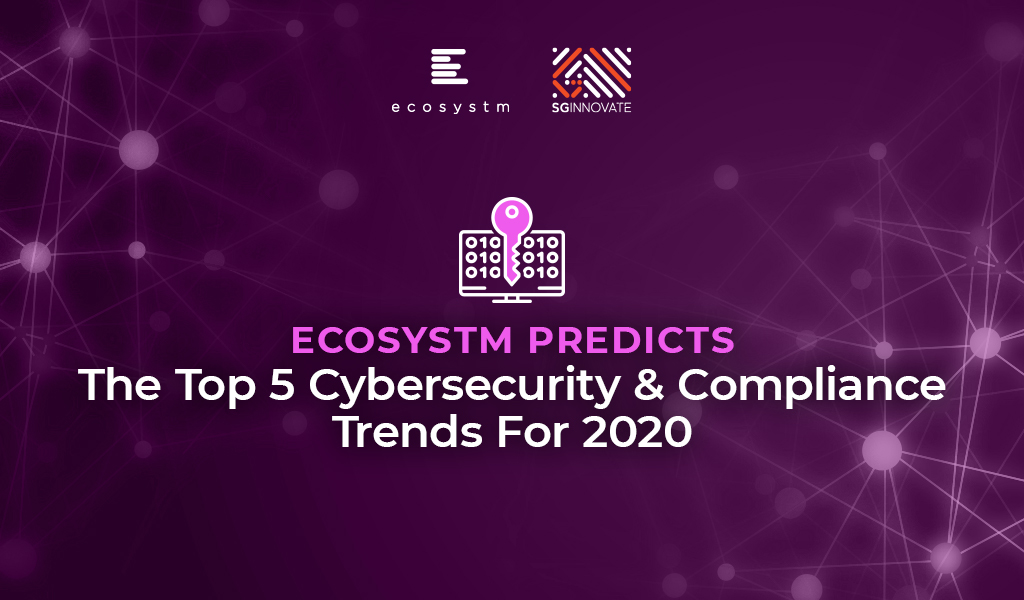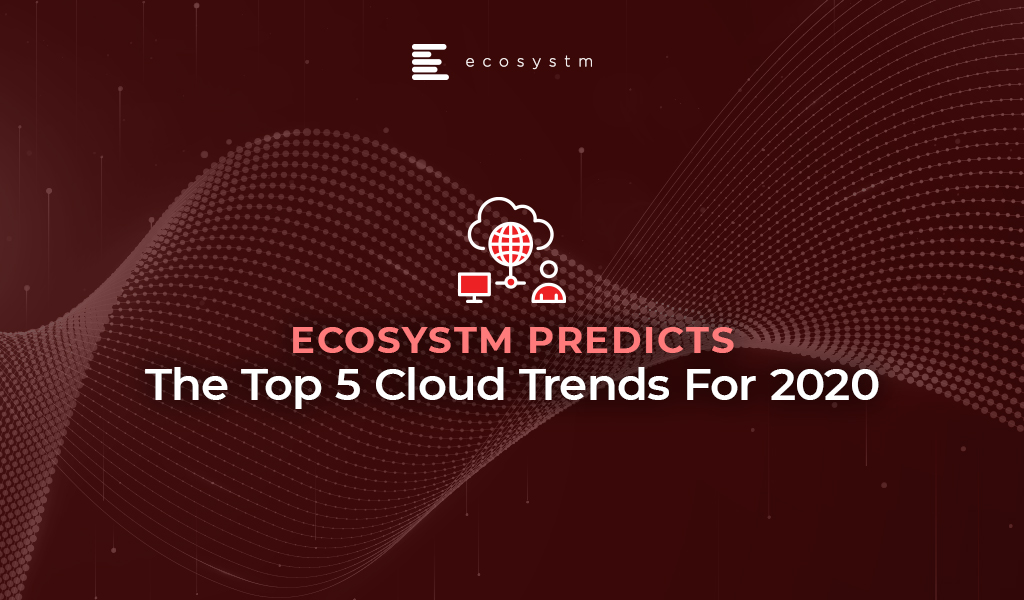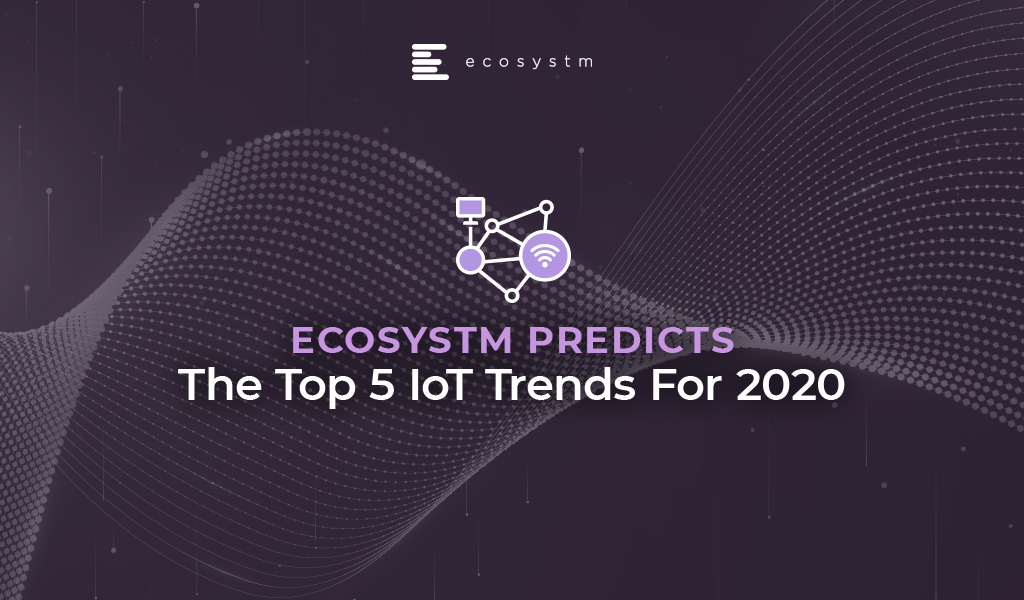As we move into a new decade, the Telecommunications industry is ripe for disruption, as it gets reshaped by bountiful bandwidth and software enabled flexibility. Several countries have spent the last decade building fibre access networks. 5G is expected to lower latency and provide greater flexibility. As virtualisation, AI and automation combine to make networks even more cost effective it will broaden use cases to include widespread adoption of IoT.
The Top 5 Telecommunications and Mobility Trends for 2020
Below are the top 5 Telecommunications and Mobility Trends for 2020. It is based on the latest data from the global Ecosystm Mobility Study and is based on qualitative research by Liam Gunson, Director, Product and Solutions at Ecosystm.
-
50 Shades of 5G
In 2020, 5G will be a major step change in what a mobile network can do – in terms of capacity, efficiency, stability, and latency. The amount of money and investment associated with it will also keep it in the spotlight. The year will see 5G move beyond trials to actual commercial rollouts – but that will also mean more regulations and a competitive landscape. There will be multiple deployment models:
- In fixed vs mobile markets, the most obvious choice will be to take a share of the home broadband space first
- Markets with strong growth in data usage and higher ARPUs will evolve 4G to provide higher bandwidth while looking to 5G for their economic benefits in efficiently managing spectrum
- In other areas, operators will be forced to explore spectrum or infrastructure sharing to spread costs across lower ARPUs or align with regulators’ desire to limit licenses. This is likely to be more common in emerging markets and low-density areas.
-
Enterprise Mobility Will Witness a Renaissance
Enterprise mobility will be back on IT teams’ agenda after having taken a backseat for a few years. Ecosystm research shows that over 72% of organisations have a Mobile First strategy. This is set to accelerate for a number of reasons:
- Companies are increasingly adopting agile or new ways of working to speed up innovation and delivery – and this includes working in new teams and activity-based working
- As more millennials and the Gen Z enter the workforce, there will be a steady rise of the ‘gig economy’ and a high percentage of contract, part-time and freelance workers
- As organisations become more agile and the workforce increasingly mobile there will be a bigger drive towards space optimisation, seeing a higher adoption of shared offices and co-working spaces
-
The Future of the LAN is Cloudy
The next few years will see a re-think of the traditional LAN/WAN set-up, as user needs change with Digital Transformation (DX) initiatives, and new technologies such as GPON, 5G, Wifi 6, WiGig, and software-defined networking bring new capabilities and alter costs. Enterprise network will change in the following ways:
- Wireless connectivity will move beyond BYOD and guest access and become the primary connection type – the connection points will be sensors and access points, and not PCs
- AI, virtualisation and software-defined networking will bring more flexibility as they lessen the need for specialised hardware, centralise control, and speed up configuration changes
- Enterprises will stop thinking of their network as a physical space and start seeing it as a set of capabilities. Equipment will be increasingly centralised in data centres (possibly on the Edge) to allow workers to work from virtually anywhere.
-
Intelligence at the Edge – from Connected Things to Conscious Things
We have moved past step 1 of IoT, where the focus was on making sensors and chipsets cheap enough to be incorporated in millions of different devices, as well as a to find cost-effective ways to handle the data requirements. 2020 will see IoT move to step 2 – from sensing to responding. AI will become easier to develop and use, while edge compute, high-bandwidth, and low latency networks will make it possible to be embedded into an expanding number of use cases where devices and processes need to make real-time adjustments.
This will become most obvious as we see an increased use of cameras as sensors. With their ability to capture details, they are the most effective sensors we can have. The challenge has been that high definition video is incredibly data heavy, creating issues when trying to transport and analyse it. Edge compute will help to bring the analytics closer to the source lowering the transport costs, while also lowering latency and increasing security.
-
Expansion Drives Consolidation
Telecommunications operators have been evolving for a while now using measures such as acquiring new companies, establishing disruptive business units and so on. In 2020, these operators will focus on transforming the core – remove unnecessary costs, improve customer experience, capture new opportunities – and on building telecom networks with scalability, flexibility, efficiency and agility.
As providers become more flexible, they will not only be easier to integrate with, but will also be able to manage more products and niche requirements. Traditionally 80-90% of their revenues have come from consumers and Telecommunications providers own these relationships. Now they will have to start working on their B2B relationships.
Ultimately the network game will be one of scale, and this will force operators to consolidate to survive. Nokia Bell Labs expects global operators to fall from 10 to 5 between 2020 and 2025, and local operators to fall from 800 to 100 – this looks completely plausible at the moment.
Download Report: The top 5 Telecommunications & Mobility Trends For 2020
The full findings and implications of the report ‘Ecosystm Predicts: The Top 5 Telecommunications & Mobility Trends For 2020’ are available for download from the Ecosystm platform. Signup for Free to download the report and gain insight into ‘the top 5 Telecommunications & Mobility Trends For 2020’, implications for tech buyers, implications for tech vendors, insights, and more resources. Download Link Below ?

Financial institutions are being challenged by and collaborating with Fintech organisations in equal measures. As their focus on customers increase, they will collaborate and partner with these disruptors. Fintech is also getting attention from governments in both emerging and mature countries as a means to achieve their financial inclusion and digital economy goals. Fintech investments will continue to surge through 2020 across the solution areas.
The Top 5 Fintech Trends For 2020
The Top 5 Fintech Trends are based on the latest data from the global Ecosystm AI and Cybersecurity studies and is also based on qualitative research by Ecosystm CEO Amit Gupta and Principal Advisor Paul Gestro.
-
One for All and All for One
Fintech will have a much greater impact than we realise, and we will continue to see it drive the induction of the unbanked into the mainstream economy. The growth in mobile phone penetration, however, continues to grow at a faster pace than banking accessibility across emerging economies. We will continue to see Fintech play a significant role in driving greater inclusion, especially to bring in the underserved in the emerging economies and reducing the gender gap when it comes to adoption of financial services – creating greater inclusion overall.
The democratisation and accessibility of financial services will also result in far greater uptake of the sharing economy and we will continue to see non-traditional companies enter the payments and financial services markets. Fintechs that have environmental and social impact, beyond financial impact, will also find it easier to secure funds from Impact Investors.
-
The Year of the Banks
2020 is the year banks will need to embrace Fintech – fully. They know full well that customers are at the centre of their entire operation – and Fintech services can and will provide them with the solutions they need. They have been skeptical about adopting Fintech but as they begin their transformation journeys and face increasingly stringent regulations, they might no longer have the option of ignoring Fintechs.
Banks are already adopting, evaluating and developing strategies for AI, RPA, and Cybersecurity adoption – but they will feel the need for more innovation and speed in 2020.
-
Asia Becomes Middle Earth
Asia has fast become the centre for both innovation and investment. Asia’s fast pace of urbanisation and the increasing prosperity of the middle class is attracting investments. Venture capital-backed Fintech companies raised more than USD 40B in 2018 – with the bulk coming out of China. Investments in Asia is expected to grow, and will benefit later stage Fintech startups.
These investments, a lack of strict policies (yet!) and the large number of unbanked and underbanked are also fuelling innovation in Asia. Several large financial institutions in Asia have already made public announcements of the Fintech investments and this will cause a ripple effect.
-
Nothing Artificial About AI
AI sits at the heart of most Fintech solutions. And AI has slowly made its way in decision-making and process automation. The first step to AI is automation and robotic process automation (RPA) will transform customer experience and will allow integration of legacy systems in financial institutions. As IoT and Blockchain mature they will be increasingly integrated within AI solutions.
Another area which will see AI adoption in financial institutions is Cybersecurity – machine learning can predict the patterns of criminals (or rogue/irresponsible employees) to stop events before they start. Fintech solutions such as Regtech and Suptech has a definite play in this space.
-
Regtech Will Take Centre Stage
In 2020, Regtech will take the centre stage as the emerging Fintech solution. Together with AI, a better ability to use data and predict trends, Regtech will be used to fight financial crime and reduce costly compliance-related mistakes.
The old way of just employing more people to run the compliance tasks is not sustainable. routine tasks such as KYC, AML and compliance verification are ripe for automation. Moreover, Regtech ROI is relatively easier to set and measure.
Download Report: The top 5 Fintech trends for 2020
The full findings and implications of the report ‘Ecosystm Predicts: The Top 5 Fintech Trends for 2020’ are available for download from the Ecosystm platform. Signup for Free to download the report and gain insight into ‘the top 5 Fintech trends for 2020’, implications for tech buyers, implications for tech vendors, insights, and more resources. Download Link Below ?

Increasingly organisations are looking to improve customer and employee experience over other traditional metrics such as growing revenue or reducing costs. Organisations are transitioning from business metrics to customer experience (CX) ones, and employing CX leaders. 2020 will see many businesses make significant breakthroughs in improving the CX.
The top 5 Customer Experience trends for 2020
Here are the top 5 CX trends and the related technology markets in 2020. It draws on the latest data from the global Ecosystm CX Study that is live and ongoing on the Ecosystm platform and based on qualitative analyses by Ecosystm Principal Advisors Tim Sheedy and Audrey William.
-
Asia will Catch up with North America and ANZ in Customer Obsession
Many Asian economies – particularly those in Southeast Asia – have not needed to focus too much on CX. The proportion of businesses starting to map customer journeys is accelerating, and there is a growing focus on making those journeys easier, more effective and more enjoyable. We are seeing this play out in the levels of interest in – and deployment of – cloud contact centres. Australia and New Zealand have been leading the deployments in the last two years. Deploying cloud and using machine learning and AI at the core to understand how to deliver personalised CX is part of a wider CX strategy for several organisations.
In 2020 we expect large organisations in Southeast Asia and North Asia to transform their CX and contact centre capabilities and make the move to cloud-based contact centre environments.
-
CX Initiatives will Dovetail with Broader Digital Ones
Many businesses have taken a bimodal IT approach to their technology platforms – driving customer-centric changes at pace while keeping their back-end systems slow. In the drive to make the entire business fast and innovative, these back-end systems are being modernised. But over 90% of businesses have not yet seen a customer or business benefit from this digital agenda.
This will change in 2020 as more businesses get some competitive advantage from the digital initiatives they are driving inside of their business. This will be driven by the linking of the customer-centric technology initiatives with the back-end ones. This means that customer applications will be infused with data and analytics from other systems, making them smarter and increasing the potential for automation and AI to drive down costs and increase personalisation and customisation.
-
Hyper-personalisation will Move from Concept to Reality – Powered by Customer Journey Analytics
The idea of creating unique experiences for each customer has been discussed for years – but few businesses are really doing it today. 2020 will see businesses outside of the top 5% experiment and deploy hyper-personalised CX. It will move from the top web brands to mass market as more companies invest in automation, predictive analytics and AI.
But hyper-personalisation is not possible without Customer Journey Analytics. Businesses need to understand the end-to-end journey of each customer to understand how to personalise it. Therefore, Customer Journey Analytics will take centre-stage in 2020. The challenge for years has been that customer teams have focused on the traditional inbound and outbound interaction with the customer. Brands now need to understand and personalise the experience before the customer interacts with the brand and after they are done interacting with the brand. The ability to apply machine learning and AI to offer insights to predict the movement and journey of the customer will be a significant focus – and challenge – for customer teams. Customer Journey Analytics will allow brands to deliver that “frictionless” service.
-
There will be a Renewed Focus on Compliance and Security in CX
With the recent banking royal commission hearings in Australia to GDPR and other global regulations around privacy and customer data handling, customer teams will now have to make sure that all forms of voice and non-voice interactions are monitored close to 100% of the time. Very few customer teams do that today and are at risk of non-compliance. As monitoring can be labour intensive, there will be a need for organisations to invest in analytics and AI applications around compliance and monitoring.
The recording of customer calls means that highly sensitive information could be stored for years and the risk of the contact centre breaching regulatory compliance requirements enhances. Solutions today have various ways to block the recording of key phrases or sections and some solutions apply APIs to the flow of the recording. As soon as the agent enters sensitive information such as credit card details, the recording stops to resume after the sensitive data is blocked or deleted. That way the sensitive conversation is not recorded or heard by anyone monitoring the call. Contact centres must adhere to this strictly, but few do. Businesses also need to know real time if an agent is misinforming the customer. Contact Centre Outsourcers will also have to re-look at how compliant they are and how much they have invested in securing customer data. There will be greater pressure on them to take on greater risks and share the risk burden with their clients.
-
Businesses will Use AI and Analytics to Measure CX
The drive to improve CX has every business and government department measuring the experience at every opportunity. A one-minute transaction in a store can prompt a five-minute survey asking for feedback. As a consequence, customers are experiencing survey fatigue. Surveys are also not the best way to measure how customers feel after they have interacted with a brand. Already, many will not participate unless there is a discount or incentive, which eats into future margins. Smart businesses will begin to use AI to detect emotions and mood, and analytics to measure experiences.
Download Report: The top 5 Customer Experience trends for 2020
The full findings and implications of the report ‘Ecosystm Predicts: The Top 5 Workplace of the future Trends for 2020’ are available for download from the Ecosystm platform. Signup for Free to download the report and gain insight into ‘the top 5 Workplace of the future trends for 2020’, implications for tech buyers, implications for tech vendors, insights, and more resources. Download Link Below ?

The future of cities is critical to the future of the global economy, given that they now account for more than half of the world’s population and more than 80% of global GDP. Cities around the world have very similar struggles and objectives: ensuring a competitive economy, a sustainable environment, and a high quality of life for their citizens. We look at the trends for cities in 2020 from the lens of data, mobility, energy, public safety, and jobs.
This article presents the top 5 Cities of the Future trends for 2020 and the related technology markets. It draws on the latest data from the global Ecosystm IoT Study that is live and ongoing on the Ecosystm platform and based on qualitative analysis by Ecosystm Board Advisor Randeep Sudan and Ecosystm Principal Analyst Sash Mukherjee.
The top 5 Cities of the Future trends for 2020
Here are the top 5 Cities of the Future trends for 2020 that we believe will impact governments, businesses and citizens in 2020:
- The Emergence of Data Smart Cities
The global economy is fast becoming digital, and data is at the very heart of a growing digital economy. Cities are increasingly adopting Data Smart strategies, a trend that will dominate the market in 2020.
Data Smart strategies focus on addressing data silos and making data available across organisational boundaries for better decision making. They expand the availability of data through real-time capture with the help of IoT devices and leverage the power and promise of data by using Artificial Intelligence (AI) and data analytics. Singapore is an excellent example of how Data Smart cities are designing their data strategies. Singapore‘s data governance framework includes the concept of Single Sources of Truth (SSOT) – where all government stakeholders have access to the same data. To make access easier, there are data aggregators, the Trusted Centers (TCs). Not only has the Government thought out the data aggregation and management angle, but also of digital enablers for the use of AI, including a code repository for AI and platform for the rapid development of AI-based solutions.
-
Intelligent Infrastructure for Smart Mobility
Traffic congestion and pollution have become an inevitable by-product of urbanisation, especially with the rise of individually owned cars. Several cities across the world have tried wide-ranging initiatives such as road space rationing and congestion pricing. However, the success of these initiatives will lie with intelligent infrastructure and smart enforcement.
2020 will see several cities making investments in demand-responsive services, where public transportation systems can respond in real-time to the changing traffic needs of the city rather than run on predetermined routes and schedules. There will also be a rise in the number of transport options, including mass transit, car-sharing, bike-sharing, ride-sharing, and personal mobility devices.
-
Smart Energy Ecosystem
Urbanisation will see higher energy costs, and a fierce competition for resources. Smart Cities are actively focusing on smarter energy options that focus on reducing energy consumption, lowering emissions, and providing better service and support to consumers.
The Energy & Utilities industry has been the first adopters of Smart Energy solutions and as they introduce smart meters for the consumers, they open the market up. The initiatives range from promoting a greener environment, expanding the use of renewable energy, and introducing ‘smart’ solutions to utility providers, enterprises, and homes.They can also help Energy and Utilities companies to comply with government regulations and meet sustainability and carbon emission goals. On the consumer side, going forward, the Construction industry is expected to be the frontrunner in promoting energy efficiency, with increasing uptake of Smart Building solutions.
-
The Rise of the Gig Economy
All Cities of the Future need to prepare for the workforce of the future. The gig economy will have a huge number of part-time, contract workers and freelance workers. This trend will only go up as more millennials and the Gen Z enter the workforce. They will force organisations to innovate and make employee experience a key business priority.
Simultaneously, there has been a steep rise in the sharing economy, seeing peer-to-peer (P2P) economic activities, based primarily on providing a service or sharing access to goods and services. Community-based online platforms are on the rise, and several industries – such as financial services, hospitality, and retail – are being disrupted in both mature and emerging economies.
-
Increased Use of AI in Public Safety
In this world of hyper-surveillance, cities use CCTV cameras for multiple reasons ranging from traffic monitoring, remote asset tracking, and crime prevention. Airports and police departments have been actively using facial recognition. They have also been experimenting with advanced video analytics that can identify persons of interest through other parameters such as gait.
Surveillance is not the only use of AI in governments. Predictive analytics is being used by police departments and the judiciary, for risk assessment and crime reduction. AI for process optimisation also impacts public safety. While discussions and debates on ethics will be rampant, most governments will invest in AI for public safety.
Ecosystm in partnership with SGInnovate, the government-backed organisation that promotes Deep Tech in Singapore, released a series of four reports covering areas of mutual interest: Cybersecurity, Artificial Intelligence, Cities of the Future and Healthtech.
‘Ecosystm Predicts: The Top 5 Cities of the Future Trends for 2020’ report is a part of this collaboration and is available for download from Ecosystm and SGInnovate websites.
Download Report: The Top 5 Cities of the Future trends for 2020
The full findings and implications of the report ‘Ecosystm Predicts: The Top 5 Cities of the Future trends for 2020’ are available for download from the Ecosystm platform. Signup for Free to download the report and gain insight into ‘Top 5 Cities of the Future trends for 2020’, implications for tech buyers, implications for tech vendors, insights, and more resources. Download Link Below ?

As the Healthcare industry becomes more consumer-focused, and consumers more tech savvy, even the most traditional healthcare organisations will have to innovate. The industry will see several instances of innovation whether new clinical research-backed, scientific solutions, technology disruptors such as IoT, Artificial Intelligence (AI), machine learning and Blockchain or business model and process changes.
This article presents the Top 5 Healthtech Trends for 2020 for the Healthcare market in 2020. The trends are drawn from the findings of the global Ecosystm Customer Experience (CX) and Artificial Intelligence (AI) studies and is based on qualitative research by Ecosystm Principal Analyst Principal Analyst Sash Mukherjee.
The Top 5 Trends for Healthtech for 2020
Here are the top 5 healthtech trends for 2020 that we believe will impact healthcare organisations (provider, payer and life sciences), patients and consumers in 2020.
-
The Shift from Patients to Customers Will Become Real
As more devices (consumer and enterprise) and applications enter the market, people will take ownership and interest in their own health outcomes. This will see a continued growth in online communities and comparison sites (on physicians, hospitals, and pharmaceutical products). Increasingly, insurance providers will use data from wearable devices for a more personalised approach, promoting and rewarding good health practices.
Beyond the use of wearables and health and wellness apps, we will also see an exponential increase in uptake of home-based healthcare products and services, whether for primary care and chronic disease management, or long-term and palliative care. The desire for real-time access to healthcare has led to a rapid consumerisation of the industry and has forced healthcare providers to actively focus on customer experience (CX), which according to the global Ecosystm CX study is the top business priority for healthcare organisations today.
-
Healthtech Will Take Lessons from Fintech
Healthcare organisations will take lessons from other customer-focused industries such as hospitality, retail and financial services. A focus on CX will also require an omni-channel strategy.
Given the similarities between the financial and healthcare industries (stringent regulations, process-based legacy systems and so on) Fintech organisations will teach Healthtech organisations how to disrupt the industry. Like Fintech, Healthtech play a greater role in inclusion – ensuring health and wellness for all, including universal health coverage. As the industry focuses on value-based outcomes, governments introduce more regulations around accountability and transparency, and people expect the CX that they get out of their retail interactions, Healthtech start-ups will become as mainstream as Fintech start-ups.
-
Healthcare Providers Will Jump on the Innovation Bandwagon
Traditionally, healthcare providers have lagged behind payer and life sciences organisations when it comes to innovation. However, that is changing fast as several provider organisations now have innovation centres, where ideas on how to improve operational parameters and clinical outcomes are incubated. They are also being creative when it comes to getting funds for these programs.
Incorporating the newest scientific advances into care protocol is largely driven by finances. But technology disrupters such as IoT, AI and machine learning are being incorporated with Operations as the key area of focus. As provider organisations increase their customer-focus, CX initiatives such as access to records, reducing waiting periods, streamlining billing and so on, will be addressed in several organisations. Innovative payment solutions (involving both patients and insurance providers) may well be the low-hanging fruit for innovators as they have the potential to significantly improve both revenue cycle management and CX.
-
Data Will Cause the Next Healthcare Divide
There has always been a divide in healthcare – based on economic and geographic parameters. A new divide will open up based on how organisations are able to leverage the huge amount of data that they are sitting on. How they leverage the data will impact an organisation’s ability to improve patient loyalty and to gain an edge over their competition.
On the one hand, governments are encouraging the three main branches of the healthcare industry that have depended on each other but worked in silos, to be more collaborative and share data. On the other hand, if we ask healthcare organisations about their biggest challenge in implementing emerging technologies such as AI, they will cite lack of data access. Organisations must also bear in mind that introducing tech innovations will be largely useless without changes in business processes that allow for these innovations, and without education and involvement of the entire organisation.
-
Life Sciences and Medical Devices Organisations Will be Forced to Rethink their R&D
The responsibility of cutting-edge research in Healthcare has always been on life sciences and medical devices organisations. Life sciences companies operate in an extremely competitive global market where they have to work on new products against a backdrop of competition from generics and a global concern over rising healthcare expenditure. Apart from regulatory challenges, medical devices manufacturers also face immense competition from local manufacturers as they enter each new market.
Sales and distribution for these organisations have been traditional – using agents, distributors, clinicians and healthcare providers. But now they need to change their go-to-market strategies, target patients and consumers directly and package their product offerings into value-added services. This will require them to incorporate CX enhancers in their R&D, going beyond drug discovery and product innovation.
Ecosystm in partnership with SGInnovate, the government-backed organisation that promotes Deep Tech in Singapore, released a series of four reports covering areas of mutual interest: Cybersecurity, Artificial Intelligence, Cities of the Future and Healthtech. ‘Ecosystm Predicts: The Top 5 Cities of the Future Trends for 2020’ report is a part of this collaboration and is available for download from Ecosystm and SGInnovate websites.

Artificial Intelligence has come a long way and was one of the growing areas in 2019. Over the last few years, we have seen a growing number of AI based platforms, applications and tools that developers and scientists have worked to mimic a human brain. We believe that in 2020, AI will come out from the experimentation stage to the implementation and businesses will make deeper investments in AI to embed them in business applications.
This article presents the Top 5 Artificial Intelligence Trends for 2020 for the AI/Analytics market in 2020. It is based on the latest data from the global Ecosystm AI Study, and qualitative research by Ecosystm Principal Advisor Tim Sheedy.
The Top 5 Artificial Intelligence Trends for 2020
Here are the Top 5 Artificial Intelligence trends for 2020 that we believe will impact both businesses and consumers in 2020.
-
Digital Transformation puts Analytics Back on Top of the Tech Priority List
In an effort to help the business operate faster, IT teams are looking to better analytics to drive functions and decisions more accurately. While many business teams deploy their own technologies and systems – only the IT team is in a higher position to gather data from multiple systems of record in order to create the detailed insights that business users demand. Getting a view across the entire customer journey means analysing data across many systems – both front and back-end. Business teams struggle to get these types of insights on their own, which is why IT excels at providing great analytics to help make better and faster decisions.
Just like in previous generations of BI, the analytics market is starting to consolidate. While the ability to display data visually will always be important, it is the analytics that drives automated decisions that will often be of the most business value.
-
Automation will Lead Organisations to AI
RPA is increasingly moving beyond the usual task and process automation, to now being a business transformation lever. Additionally, there is an immense focus on incorporating AI/machine learning within RPA to make automation smart and intelligent. This allows software robots to mimic human behaviour and handle complex use cases, which was earlier not possible without human intervention.
Businesses will spend more money on their simple automation activities (RPA and analytics applications that do not learn) – but those that have already invested in automation are likely to want to take the next steps to AI.
-
AI will Start to be Embedded in Most Business Applications
To date AI has been an overlay to most applications – data is extracted from processes, learnings are made, and then the process is altered based on those learnings. In 2020 we will see mass availability of self-learning intelligent applications. The standard ERP, CRM, SCM, knowledge management solution and other business applications will have embedded intelligence. This will make it easier and faster for businesses to get the benefits of machine learning and AI without the need to hire expensive data scientists, or the requirement to learn the tools and platforms required for creating smart applications.
-
2020 will see the Democratisation of AI
Typically organisations required data scientists, AI coders, AI platforms and so on to do well in AI but with the increasing availability of AI in business applications, typical business users will begin to get a glimpse of what will be available at their fingertips in the next few years.
We expect templatised approaches to machine learning and associated technologies. Business users and data owners will be able to create algorithms that will improve business and customer outcomes. In some cases, we even expect AI to be available to consumers. We will start to see banking and finance applications that help better money management through learning – not just basic analytics, we will see more intelligent services in the market in 2020.
-
More Businesses Will Require AI on the Edge
In the next decade or two, it is estimated that there will be 100 billion IoT devices generating and exchanging data into the cloud, without any human intervention. With so many IoT devices generating a huge quantum of data, decisions will need to be made in real-time and the current cloud environments will be a bottleneck in data processing due to latency rates, network speed and traditional data architectures. To overcome this, Edge Computing solutions will be essential to work with a variety of sensor and data input devices, information processing and decisions driven by machine learning and AI, and additionally work with cloud for the next level of analytics, decisions and management.
Ecosystm in partnership with SGInnovate, the government-backed organisation that promotes Deep Tech in Singapore, released a series of four reports covering areas of mutual interest: Cybersecurity, Artificial Intelligence, Cities of the Future and Healthtech. ‘Ecosystm Predicts: The top 5 Artificial Intelligence trends for 2020’ report is a part of this collaboration and is available for download from Ecosystm and SGInnovate websites.
Download Report: The Top 5 Artificial Intelligence Trends for 2020
The full findings and implications of the report ‘Ecosystm Predicts: The Top 5 Artificial Intelligence Trends for 2020’ are available for download from the Ecosystm website. Signup for Free to download the report and gain insight into ‘the Top 5 Artificial Intelligence Trends for 2020’, implications for tech buyers, implications for tech vendors, insights, and more resources. Download Link Below ?

Cybersecurity will remain an important topic of discussion on the world forum. 2020 is predicted to see an increasing number of state-sponsored cyber-attacks especially on utilities and public infrastructure. In addition, the number of AI based devices will increase which will receive specific attention from regulators for data and cybersecurity. Finally, there will be opportunities for mergers and acquisitions and investments in established cybersecurity providers to remain innovative and growing.
Here are the Top 5 Cybersecurity Trends for 2020, that we believe, will impact both businesses and consumers in 2020.
The Top 5 Cybersecurity Trends for 2020
The Top 5 Cybersecurity Trends for 2020 are drawn from the findings of the global Ecosystm Cybersecurity Study and is also based on qualitative research by Ecosystm Principal Advisors Alex Woerndle, Carl Woerndle and Claus Mortensen.
-
API Vulnerabilities will Become a Main Hacker Target
APIs grant access and provide transparency for developers – providing access and insights from both internal and external data. But they are inherently insecure. We have already seen several high-profile API breaches and announced API bugs. For example, in October 2018, Google had to shut down Google+ after an API bug exposed details for over 500,000 users.
We believe the problem will get significantly worse in 2020, with API attacks quickly becoming one of – if not the most – frequent target for hackers.
-
Operational Technology Security will Continue to Lag in 2020
Operational Technology (OT) refers to the hardware and software used to monitor and manage how devices that run on an organisation’s infrastructure perform. These devices have become smarter, remotely accessible and increasingly connected to networks. However, they were never designed with this in mind.
With organisations continuing to focus on data breaches – the investment in OT security will continue to lag. This will create a ‘security debt’ over coming years for those that do not invest in preventative controls now.
-
AI Training will Receive Attention from Regulators and the Public as a Possible Infringement of Privacy
News that Amazon’s Alexa was eavesdropping on its users, and that Apple’s Siri and Google’s Assistant, also kept recordings to help train their AI raised many concerns about how data to train AI is collected and stored. Apart from the initial consternation in the press and on social media, nothing much seems to have happened from a regulatory perspective.
2020 will be the year when AI training relying on consumer data will start to become regulated.
-
Major GDPR Fines in 2020 will Force MNCs to Invest in Security Compliance
GDPR came into effect in May 2018, but we still have not seen huge amounts of fines being issued in the EU. Only two fines were issued in 2018, while at least 17 were known to be issued in the first half of 2019, totalling about EUR 52 million. In the third quarter of 2019, at least 12 fines were issued totalling about EUR 328 million.
The trend is clear: Expect to see a magnitude of companies across EU be penalised in 2020. We also expect several fines above EUR 100 million and GDPR impacting countries outside the EU.
-
Mergers & Acquisitions will Ratchet up Significantly in 2020
The fragmented global security market consists of thousands of vendors and consultancies. Every day a swathe of new start-ups announces their ground-breaking new technology. Coupled with significant investments in tertiary education and industry certifications for a growing workforce, the next generation of cybersecurity entrepreneurs are entering with force.
We believe that this creates both threats and opportunities for established cybersecurity providers that need to remain innovative and growing. Similarly, this presents smaller or more niche cybersecurity start-ups with an avenue for funding or acquisition.
Ecosystm in partnership with SGInnovate, the government-backed organisation that promotes Deep Tech in Singapore, released a series of four reports covering areas of mutual interest: Cybersecurity, Artificial Intelligence, Cities of the Future and Healthtech. ‘Ecosystm Predicts: The Top 5 Cybersecurity Trends for 2020’ report is a part of this collaboration and is available for download from Ecosystm and SGInnovate websites.
Download Report: The top 5 Cybersecurity trends for 2020
The full findings and implications of the report ‘Ecosystm Predicts: The Top 5 Cybersecurity Trends for 2020’ are available for download from the Ecosystm platform. Signup for Free to download the report and gain insight into ‘the top 5 Cybersecurity trends for 2020’, implications for tech buyers, implications for tech vendors, insights, and more resources. Download Link Below ?

As organisations look to leverage better operational and business insights, adopting Cloud has become imperative for them, especially for those that intend to make use of other technologies like analytics and IoT. All the imperatives for moving to Cloud continue to grow stronger, while at least some of the reasons for resisting the trend are becoming indefensible. The key inhibitors continue to be security and data privacy concerns and back-up/connectivity issues. Also, as the Cloud ecosystem has matured, an important inhibitor has become cost considerations as many organisations are now evaluating whether the Cloud is indeed more cost-effective than on-premises options.
This article presents the Top 5 Cloud Trends for 2020 for the Cloud market in 2020. It is based on the latest data from the global Ecosystm Cloud, IoT and Cybersecurity studies, that are live and ongoing on the Ecosystm platform, and qualitative research by Ecosystm Principal Advisors Claus Mortensen and Craig Baty.
The Top 5 Cloud Trends for 2020
Here are the Top 5 Cloud Trends for 2020 that we believe will impact both businesses and consumers in 2020.
-
Major Cloud Providers Will Push for Open Source
Open Source has always played a big role in Cloud and as we move into 2020, its role will only grow bigger. Infrastructure and Platform Clouds may not have been dominated by Open Source in the past, but all major Cloud players such as AWS, Microsoft, and IBM have been focusing on Open Source recently.
In 2020, major cloud providers will switch to Open Source to create a development environment that can achieve more than they would be able to develop fully in-house.
-
Open Source will Drive the Adoption of Serverless Computing
Serverless computing is a cloud model where the Cloud provider runs and manages the server and the allocation of machine resources. Beyond just the individual servers, many vendors are now offering to totally replace the data centre with a virtual version that runs in the Cloud.
It has the potential to become a widely used solution for mid-range businesses. A dynamically scaled and priced data centre could offer them a much more flexible IT environment where they do not have to worry about capacity planning and scaling – even when compared to a more traditional Cloud environment.
-
Cloud and IoT Will Drive Edge Computing
Edge computing has been widely touted as a necessary component of a viable 5G setup, as it offers a more cost-effective and lower-latency set up than more traditional infrastructure. Also, with IoT being a major part of the business case behind 5G, the number of connected devices and endpoints is set to explode in the coming years, potentially overloading an infrastructure based fully on data centres for processing the data
Although some are touting Edge computing as the ultimate replacement of Cloud, we believe it will be complementary rather than a competing technology – at least in the foreseeable future and certainly as far as 2020 is concerned. Edge computing will allow Cloud providers to better cater to companies that need low latency, quick access to data and data processing. On the mobile side, it will allow them to push workloads to the handset, reducing the backend workload and potentially enhancing data privacy.
-
‘Cloud Creep’ Will Get Worse Before It Gets Better
What we have previously referred to as “shadow IT” is rapidly spreading – and worsening – as organisations move to the Cloud and many organisations are now suffering from what is referred to as “cloud creep”. There are several implications of cloud creep – the most significant ones being security issue and cost.
As the use of stand-alone Cloud services grows, the risk of sensitive data being used, stored and shared in non-compliant ways increases. As for cost, while LoB sourcing of Cloud services may save the strain on the IT department’s budget as the money may come from a different “bucket”, it makes it very difficult to get a true picture of the organisations total IT spend and it may mean that consolidation benefits from well-managed sourcing and usage cannot be achieved. A third and increasingly important factor is energy footprint and savings. A fall-out from cloud creep is increased “server sprawl” whereby virtual machines (VMs) and applications remain under-utilised, leading to poor productivity and proficiency.
-
Alliances and Partnerships Will be Formed as the Battle for the Top Heats Up
The global Cloud market has been consolidating around 5 players: AWS, Microsoft, Alibaba, Google and IBM. Nothing really suggests that this trend will change in 2020.
But even for the current top 5 players, their ability to compete will increasingly come down to their ability to expand their service capabilities beyond their current offerings. Ecosystm expects these players to further enhance their focus on expanding their services, management and integration capabilities through global and in-country partnerships. One particular area might be partnerships – focusing on Cloud migration between Clouds and from Cloud to on-premises.
Download Report: The Top 5 Cloud Trends For 2020
The full findings and implications of the report ‘Ecosystm Predicts: The Top 5 Cloud Trends For 2020’ are available for download from the Ecosystm website. Signup for Free to download the report and gain insight into ‘the top 5 Cloud trends for 2020’, implications for tech buyers, implications for tech vendors, insights, and more resources. Download Link Below ?

The industry has been enthusiastic about the number of devices and sensors that are expected to increase exponentially in 2020 and beyond. The role of the Internet in Things (IoT) in delivering ‘Smart’ solutions is seeing unprecedented interest in technology. However, 2020 will be the year when IoT adoption will see a sharp increase in uptake as 5G rollouts gather steam and governments across the world focus on Smart City initiatives.
Here are our predictions on the Top 5 IoT Trends for 2020, that we think, will shape the Internet of Things landscape over the next 12 months.
The Top 5 IoT Trends for 2020
The Top 5 IoT Trends for 2020 are based on the findings of the global Ecosystm IoT and AI studies, and is also based on qualitative research by Ecosystm Principal Advisors Francisco Maroto and Kaushik Ghatak.
-
5G Providers Will Be Forced to Operate Outside their Comfort Zone
Network and communications equipment providers have much to gain and more to lose as organisations look to leverage 5G for their IoT use cases. Each industry will have their different and distinct use cases – the use cases for Oil & Gas will be different from Retail use cases, which will be different from Healthcare industry requirements.
Telecommunications providers will find themselves depending on systems integrators (SIs) with relevant industry experience, to translate the value proposition of what they are offering. However, the telecommunications providers are not companies with actual skin in the game. If 5G uptake does not take off, the bigger losers will be the network and communications equipment providers – the real investors in the technology.
-
Satellite IoT Connectivity Solutions Will Start to Compete Against and Work with LPWANs
Current satellite communications technologies have not been designed specifically for IoT and may fail to meet the specific requirements of the IoT market, especially when it comes to price and ease of use.
This is set to change as both incumbents and new entrants in the satellite space seek to grow their IoT markets in 2020. Satellite communications companies are designing a spectrum strategy and a go-to-market strategy that include collaboration with Low Power WAN (LPWAN) vendors.
-
IoT Sensor Analytics Will Become the Fastest Growing AI Workload
Many organisations will actually start their digital journey and their investments in AI even before they invest in automation – when they start to analyse the data from their IoT sensors and make sense of the ‘data sprawl’ that is created as the number of data collection points proliferate. Organisations’ desire to transform, starting with automation, will further drive the adoption of IoT. The global Ecosystm AI study reveals that organisations investing in IoT sensor analytics also look to invest in computer vision and automation solutions. IoT adoption will enable organisations to focus on incorporating AI/machine learning to make automation smart and intelligent.
-
Construction Will Become the Unsuspecting Influencers for IoT Adoption
The construction industry is fast emerging as the arena for end-to-end IoT-driven services especially as new-age companies link architects with contractors with building managers with facilities management to create a new meaning of ‘Smart Buildings’. Realtors become unsuspecting influencers as they establish Smart Building ecosystems. According to the findings of the global Ecosystm IoT study, the top solutions that construction companies have implemented and are evaluating, are primarily aimed at ensuring operational and employee safety. However, the industry will also see an uptake of customer management IoT solutions aimed at providing better customer experience (CX).
-
The Edge Will No Longer Be at the Edge
2020 will mark the end of the hype around the Edge and the way we think about it. Real-time analytics will be performed at so many places along with the network and infrastructure that IT management will be forced to rethink their distributed and enterprise computing strategies. The main industries that will see a growth in Edge uptake in 2020 will be Manufacturing, Retail, Energy, Healthcare, Transportation and Logistics.
As the Edge technology develops, the application of AI will steadily move away from centralised servers (on-premise or cloud) to the edge devices themselves. There are two important benefits to this – Firstly, it minimises time lag between data acquisition and secondly, any targeted hacking attempt can be immediately identified and mitigated, rather than being at the mercy of the security systems implemented by the cloud provider.While AI-enabled edge devices tend to be costlier than
their “dumb” counterparts, the value they can bring in terms of being able to immediately act upon the data, and the additional security they can potentially provide, can be significant factors that offset the high initial cost of deployment.
Download Report: The Top 5 IoT Trends For 2020
The full findings and implications of the report ‘Ecosystm Predicts: The Top 5 IoT Trends For 2020’ are available for download from the Ecosystm website. Signup for Free to download the report and gain insight into ‘the top 5 IoT trends for 2020’, implications for tech buyers, implications for tech vendors, insights, and more resources. Download Link Below ?



